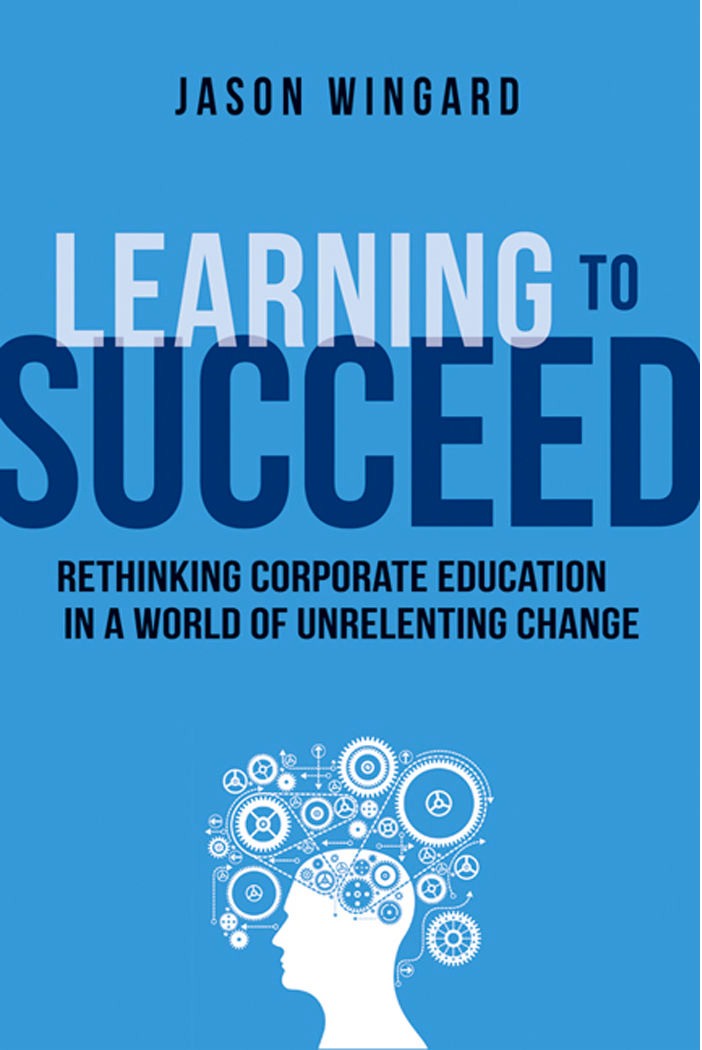 Learning to Succeed, by Jason Wingard, PhD, explores the
relationship between corporate strategy, operational planning, and human
capital development. Wingard is dean and professor of the School of
Professional Studies (SPS) at Columbia University, and also president and CEO
of The Education Board, Inc., a boutique management consulting firm. In the
past, he was chief learning officer at Goldman Sachs, and served as vice dean of
the Wharton School, University of Pennsylvania.
Learning to Succeed, by Jason Wingard, PhD, explores the
relationship between corporate strategy, operational planning, and human
capital development. Wingard is dean and professor of the School of
Professional Studies (SPS) at Columbia University, and also president and CEO
of The Education Board, Inc., a boutique management consulting firm. In the
past, he was chief learning officer at Goldman Sachs, and served as vice dean of
the Wharton School, University of Pennsylvania.
Somewhat academic in tone and definitely written at the strategic level, Wingard’s book is clearly intended for Chief Learning Officers (CLOs) and other members of corporate C-suites. In the Foreword, Indra Nooyi, Chairman and CEO PepsiCo, says, “Learning to Succeed is a guide for business advantage through corporate learning and development, and it demonstrates how to maximize continuous returns on investment.” The book will also be of interest to management consultants and possibly to managers of training, although the latter group will likely lack the authority to autonomously implement the process suggestions it makes.
Learning to Succeed is the result of four years of research Wingard conducted after the global financial crisis. It included:
- Interviews and focus groups with global CEOs, CLOs, and other C-suite executives
- Surveys and questionnaires from global division heads and business unit managers of large and small companies
- Personal observations of over 500 board and strategic planning meetings, learning and development sessions, and active work environments
- Discussions with global academics and thought leaders
Wingard makes his focus clear immediately in the introduction: today, learning is critical for fiscal survival and is the core catalyst for competitive advantage in the dynamic global marketplace. He says, “For the most successful companies, an ongoing commitment to becoming a dynamic learning organization drives their ability to position themselves ahead of the curve and remain competitive.” Learning initiatives, he believes, configured and supervised by learning professionals within the organization, increase internal communication between segments of the organization, reinforce corporate culture and community, inspire innovation, and increase productivity and profitability. No longer regarded as “soft investments,” corporate learning initiatives, training, and executive education have become crucial elements in any company’s future growth, competitiveness, and profitability.
The intent of the book is to lead senior managers to a fuller understanding of corporate learning initiatives and how they can apply these initiatives. Initiatives can work most effectively when integrated into the overall corporate strategic decision-making process. In the first chapter, Wingard provides an overview of the New Normal—the new business environment and the most powerful forces that drive it: global market shifts, business cycle variability, and focus on return on investment. It’s an articulate and complete exploration of these matters. However, it seems to me that there’s really nothing in this overview that will be news to anyone who has been in business leadership positions during the last 25 years. The biggest changes in that time have been the impact of technology on the speed of change, and the need for ever more precise and ever faster execution.
Wingard describes a process he refers to as continuous integration of learning and strategy (CILS) to give the learning organization the competitive edge in a tough marketplace. This is the heart of the book. He makes the case for why businesses need to focus on human capital management, strategy, and learning all at the same time through this process.
The CILS process defines the relationship between strategic planning and corporate learning as fundamental partners. The office of the CLO handles administration and application of CILS to drive corporate learning, training, and executive education. Wingard provides examples (vignettes and case studies) to demonstrate key points and to illustrate the application of such strategic approaches in organizations recently and why they’ve been successful. He also discusses organizations that have chosen not to do so and how they are beginning to fail even if they have been successful for the last fifty years.
Much of Learning to Succeed is concerned with implementation of the CILS process and the role of the CLO in the organization, including change management. Although Wingard says early on that he believes we are on the edge of “The Age of Learning” there is no discussion of what some refer to as the modern approaches to learning—experiential, informal, or social learning—or of “components” of training (“traditional,” i.e., classroom instruction, eLearning, MOOCs, mentoring, coaching, etc.) All of the components are only mentioned in passing in the course of a single paragraph.
While the discussion of the forces that are changing business and increasing the importance of learning to success will be of interest to practitioners who are new to business leadership, or who have not seen such an analysis, my concern remains the difficulty modern employees have “keeping up” with technology and change. I wonder whether CILS is going to help very much with this, or if it will remain a high-level approach to traditional “formal” training programs, leadership development, and corporate universities.
If you have an interest in a high-level treatment of strategic issues around corporate training, then Learning to Succeed is a complete and articulate source written with a 21st-century point of view.



